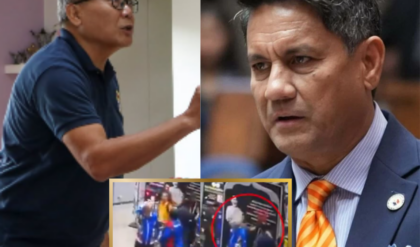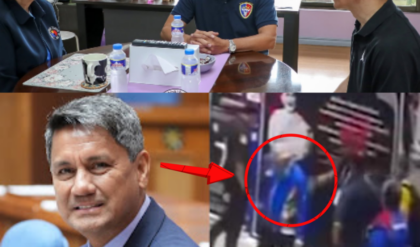The Dual Storm: Filipino Celebrities Demand Accountability Amidst Cebu’s Devastating Typhoon Floods

The recent onslaught of Typhoon Tino and the subsequent catastrophic flooding in Cebu have triggered a wave of shock, sympathy, and pointed criticism from some of the Philippines’ most prominent celebrities. While the entertainment world mobilized quickly to offer aid and prayers, many stars broke from the traditional message of resilience to demand a deeper investigation into long-standing issues of structural failure and alleged corruption surrounding local flood control projects. The collective voice of these personalities has transformed the response from a simple humanitarian crisis into a demand for governmental accountability.
The Humanitarian Outcry: Empathy and Immediate Concern
The initial reactions across social media were characterized by immediate distress and solidarity with the Cebuanos, who faced widespread destruction and displacement. Celebrities known for their compassionate nature led the charge with messages of prayer and support.
Actress Anne Curtis, a beloved public figure, immediately took to her platform to express her deep sorrow and send prayers for the affected communities. Her message joined countless others in conveying profound sadness over the widespread suffering and the massive loss of homes and livelihoods.
Similarly, veteran actor Edu Manzano utilized his social media reach to offer a powerful, yet simple, statement of faith and support. In his post, he conveyed “Sending Prayers for Safety, Protection, and Resilience to everyone affected by the Typhoon in the Philippines,” emphasizing the need for strength and endurance during the ongoing recovery efforts.
In a segment of the popular noontime show It’s Showtime on November 6, host Vice Ganda dedicated time to express his heartfelt prayers for all those affected nationwide, particularly in the hardest-hit areas of Cebu. Vice Ganda underscored the enduring Filipino spirit of bayanihan (community cooperation), stressing that mutual support is essential for all victims to eventually rise above the tragedy. “Until everyone can fully recover, we must all help each other,” he urged, emphasizing unity in times of adversity.
Angel Locsin’s Critical Intervention: Questioning Preventative Measures
Standing apart from the purely humanitarian calls, actress and noted activist Angel Locsin utilized her platform to not only express sympathy but also to pose a critical question to public authorities. Known for her hands-on involvement in disaster relief, Locsin’s disappointment was palpable.
She broke her silence to acknowledge the plight of the Cebuanos, but immediately directed attention toward the systemic issues that may have exacerbated the damage. Her post encapsulated the frustration shared by many Filipinos: “Not another one. Hoping everyone in Cebu is safe. Are we all thinking the same? Is it just because of the rain or because something could have been done to prevent it?”
Locsin urged authorities to conduct an immediate and thorough investigation into the flooding’s root causes, aiming to prevent a recurrence of such devastating events. Her call for accountability—**”Hope authorities look into this as well so it doesn’t happen again”—**reinforced her reputation as a humanitarian who is unafraid to demand better governance for those suffering.
The Emotional Weight: Cebuana Pride and Heartbreak

The devastation hit particularly close to home for celebrities who hail from the Central Visayas region, deepening the emotional connection to the crisis.
Actress Kim Chiu, a proud Cebuana, expressed profound sadness over the calamity. She noted that while her immediate area may have been spared the worst of the flooding, the sheer scale of the disaster was unprecedented in her memory of Cebu. “I hope that those who are responsible will do everything necessary so this doesn’t happen again,” she lamented.
Kim Chiu drew a parallel to past hardships, recalling how her production team (The Ali Production) had previously endured the psychological trauma of constant aftershocks during an earthquake in Cebu, necessitating constant readiness to evacuate their hotel. This shared history of trauma underscored the unique pain of seeing her hometown face yet another massive natural challenge, amplified by what many believe were preventable circumstances.
Similarly, Cebuana beauty queen Beatrice Luigi Gomez conveyed her heartbreak, showcasing images of the widespread destruction on her Instagram stories. Gomez, whose home province was severely affected, went beyond simple distress to launch a furious critique of government spending. She directly questioned the efficacy and integrity of the flood control budgets.
“Damages can occur during natural calamities but with much budget preventive measures could have been made,” Gomez argued. “Cebuanos prepared for this calamity. What else could have been done? This is exactly why we demand for these kind of projects because people can only do so much. The rest is up to the agency responsible.”
Her message resonated widely, highlighting the bitter realization that local efforts at preparedness are often negated by systemic failures and alleged corruption at the governmental level.
The Core of the Issue: The Controversial P26 Billion Flood Fund
The celebrity outrage directly intersects with a massive national controversy over infrastructure spending. Recent investigations by government and independent bodies have revealed widespread corruption and “ghost projects” across the country, particularly within flood control initiatives.
Cebu, specifically, has been at the epicenter of this financial scandal. Despite the catastrophic flooding caused by Typhoon Tino—described by the local governor as “by far the worst flash flood… in the history of Cebu”—public records show that the province received more than ₱26 billion ($440 million) in flood control funds between 2022 and 2025.
The sheer scale of this funding compared to the degree of devastation has fueled the public’s outrage, echoing the celebrities’ sentiments. As Winwyn Marquez noted, the slow pace of accountability for these billion-peso projects only intensifies the pain of the affected communities. Experts and critics argue that the use of substandard materials, the proliferation of “ghost projects,” and massive kickbacks have rendered the infrastructure useless, turning heavy rain into a deadly, preventable calamity.
The Call to Action: Disrupting the Status Quo
The disaster also prompted celebrities currently engaged in professional pursuits to pause and refocus on the national crisis.
Actor Paulo Avelino expressed the difficulty of maintaining professional focus amid the suffering. “Just hearing the news and devastation… it’s hard to continue work while you know people need help,” he admitted, acknowledging the moral burden of carrying on when compatriots are in dire need.
Even Maria Ahtisa Manalo, the Miss Universe Philippines 2025 candidate who is now in Thailand preparing for the international pageant, took time to appeal for immediate assistance for her fellow Cebuanos. This act highlighted the inherent sense of community responsibility that transcends individual career aspirations.
In a unified voice, the celebrities have done more than just sympathize; they have used their immense platforms to amplify the suffering of the poor and demand answers regarding the misuse of public funds earmarked for safety. Their intervention forces the public spotlight onto the issue of governance, reminding the nation that resilience is not an excuse for perpetual incompetence. The Filipino people, aided by the outspoken indignation of their stars, are demanding that the next phase of recovery be defined not just by rebuilding homes, but by fundamentally restructuring the system to ensure this preventable level of devastation never strikes Cebu again.





